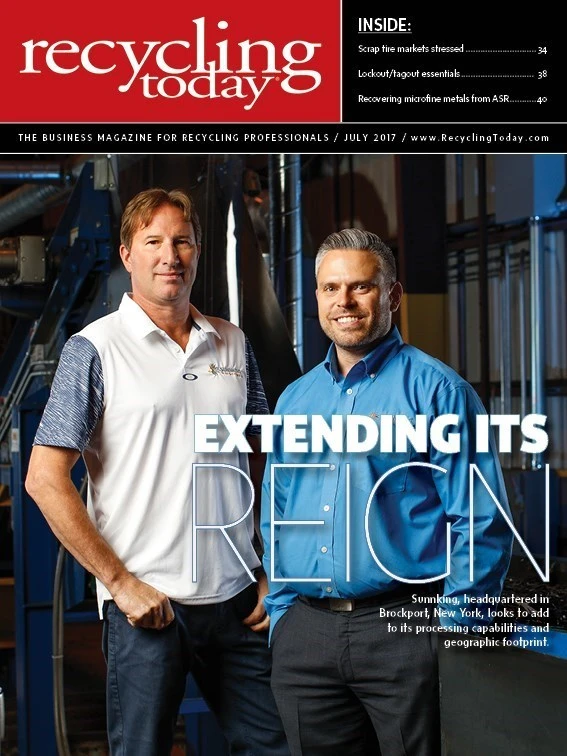
While optical sorters commonly are used to sort paper in material recovery facilities (MRFs) that handle single-stream commercial material, their use on residential fiber sort lines is increasing for a variety of reasons, according to industry sources.
“The new Chinese regulations of no more than 3 percent contamination within fiber are causing all kinds of labor issues,” John Green, president of Green Machine, Hampstead, New Hampshire, says, referring to that country’s National Sword inspection program for incoming recyclables and its impact on operators of single-stream residential MRFs. “Added labor is expensive and so is slowing the line down,” he says. “It’s becoming more expensive to sort single stream.”

Justifications for adding optics
Sources contacted for this article say that when it comes to using optical sorters for paper, in general, a frequently used phrase is “it just depends.” From whether optical sorters make sense in residential MRFs to where they should be positioned to create
“I recommend those who are considering deploying optics go through the exercise of completing a pro forma,” Green says. “It’s generally part of [Green Machine’s] offering. We look at the economics behind the deployment of optics through labor savings, increased

Green says his residential MRF customers primarily use optical sorters to recover plastics. When deployed on fiber lines, either clean fiber is sorted or contaminants, such as containers and brown grades, are targeted. Green Machine’s optical accelerator conveyors in residential MRFs are wide and fast, allowing for
In terms of spectroscopy, Green recommends hyperspectral technologies, calling them “far
“With this type of technology, we’re able to identify all types of fibers and color,” Green says. “We can sort sorted office paper from cardboard from kraft paper from news—long fiber, short fiber—it’s able to identify all grades of fibers individually or collectively.”
A typical residential MRF features one to three fiber lines. According to Green, it makes the most sense to place the optical sorter on the most contaminated line because the machine can catch more contaminants than hand sorting. For Green Machine, he says the goal is a 97 percent clean stream, and, while some manufacturers boast a 99 percent clean stream, the minimum market requirements are more realistic. “The point is to maximize tonnage while meeting minimal market criteria,” Green says.
Education and contamination
For MSS Inc. in Nashville, Tennessee, contamination is one of the greatest factors to consider when adding optics on the fiber lines of residential MRFs. This is because, Sales Director Felix Hottenstein says, “on the residential side, we’re using it to clean up news or mixed paper, not to sort higher grades.”
Residential MRFs that use MSS optical sorters have two things in common: high volumes and high contamination levels. However, he adds, “You need to have the right volume and material coming in that’s not too contaminated, or else you won’t get a higher grade.”
Optical sorters typically are installed in residential MRFs when they operate at 25 tons to 30 tons per hour with an average material stream composition. If the tonnage is lower, installing an optical sorter isn’t justifiable unless the material is extremely contaminated.
Hottenstein says MSS customers using optical sorters on their residential fiber lines offer three reasons for doing so: improved technology, reduction of manual labor and improved material quality.
Hottenstein says eight hand sorters on a line can make about 400 picks per hour, but optical sorters can make about 2,000 picks in that same time

“The savings on the manual labor is the last reason,” he says of MRF operators objectives when adding optical sorting on their residential fiber lines.
While optical sorters normally are used to sort plastic bottles, MSS can replace the sensor head and reroute the conveyor to sort fiber.
Hawn suggests moving from the VIS-NIR (visible near-infrared) spectroscopy typically found in MRFs to either a SWIR (
“For that technique to work, you need to have control on your infeed material’s temperature and humidity,” he says.
While making the plunge to install an optical sorter on a residential MRF’s fiber line can be intimidating, Hottenstein says the advancing technology makes the justification undeniable.
“I think we made quite a big step in the last two years, especially in the last two to three months,” he says. “It’s a matter of whether you save enough labor to justify it. New specifications and the need for cleaner paper from the China situation may cause more need for optical sorters, especially on the residential side. Bigger machines are more expensive, but you have to do what you have to do. You either have to save money or make money.”

Explore the July 2017 Issue
Check out more from this issue and find your next story to read.
Latest from Recycling Today
- Phoenix Technologies closes Ohio rPET facility
- EPA selects 2 governments in Pennsylvania to receive recycling, waste grants
- NWRA Florida Chapter announces 2025 Legislative Champion Awards
- Goldman Sachs Research: Copper prices to decline in 2026
- Tomra opens London RVM showroom
- Ball Corp. makes European investment
- Harbor Logistics adds business development executive
- Emerald Packaging replaces more than 1M pounds of virgin plastic





